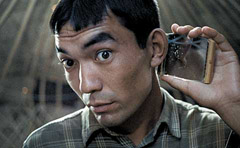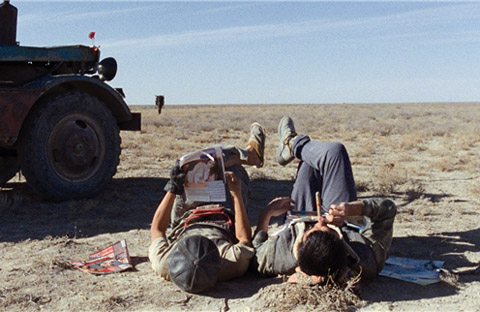Tulpan: Poverty and unrequited dreams on the Kazakh steppes
By Richard Phillips
6 May 2009
Directed by Sergey Dvortsevoy from a script by the director and Gennadi Ostrovsky
Tulpan is a deceptively simple but captivating story about a group of nomadic shepherds in the poverty-stricken Betpak Dala region of southern Kazakhstan. The movie, which is now on release in several Australian state capitals, has won several well-deserved prizes including the Un Certain Regard Award at last year’s Cannes film festival.
Betpak Dala is a sparsely populated and unforgiving semi-desert steppe of about 75,000 square kms (29,000 square miles). The area’s annual rainfall is between 100 and 150 mm (4-6 inches) and the average temperatures -14°C (7°F) in winter and 26°C (79°F) in summer.
By way of historical background, southern Kazakhstan was so geographically isolated that it was used by the Russian Tsar and then the Soviet Stalinist bureaucracy to exile political opponents. Leon Trotsky, co-leader with Lenin of the Russian Revolution, was banished by Stalin to the Kazakh city of Alma-Ata, now known as Almaty, in January 1928 before being expelled from the Soviet Union in February 1929.
At first thought this bleak location, also known as the Hunger Steppes, would seem an unlikely setting for a full-length feature, but Sergey Dvortsevoy’s 100-minute story—his first fictional film—is an extraordinary work, infused with moments of drama, sardonic humour and visual beauty. Shot over a period of 40 weeks on a budget of only €2.15 million, it is yet another demonstration that real life stories, in this case the hopes and dreams of a young Kazakh man living amongst some of the world’s poorest peoples, can provide the basis for engrossing artistic work.
Asa (Askhat Kuchinchirekov), the movie’s principal character, was born and raised on the steppes but left the region as a child. After a stint in the Russian navy, he has returned to live with his sister Samal (Samal Yeslyamova) and her husband Ondas (Ondasyn Besikbasov) and their three children—two boys and a girl.
Asa dreamt of becoming a shepherd on the steppes during his years in the navy and is determined to marry an eligible girl and raise a family. Unless he can find a wife he will not be able to obtain a flock and it will be impossible for him to survive in this strange and deeply unforgiving land. The only potential wife, in hundreds of kilometres, is Tulpan (Kazakh for tulip), the daughter of a neighbouring shepherd.
Asa also naively believes that he can become a rich shepherd and that he and his future wife will live in a modern house rather than a yurt—the large felt-covered tent-like dwelling in which most semi-nomadic Kazakh shepherds reside. These hopes are lovingly sketched on the underside of his sailor’s collar, a tradition still maintained by sailors in the Russian navy.
The movie begins in a yurt belonging to Tulpan’s parents. Ondas is attempting to persuade them that his brother-in-law is an interesting and reliable young man and capable of providing a decent future for their daughter. Asa tells Tulpan’s parents about his time in the navy, including a tall story about an encounter with a giant octopus. They’re unimpressed. He gives them a large ornamental lighting fixture as a sign of his good faith.
Tulpan, whom the audience never sees and Asa only glimpses, refuses to meet the former sailor. She wants to move to the city and get a college education. Asa and his friend Boni somehow believe that the meeting with Tulpan’s parents has been a great success and laugh and sing as they take the long drive back to the family yurt. Asa’s dreams are rudely shattered when suddenly Ondas tells him that Tulpan is not interested, and that the former sailor’s ears are “too big”.
 Asa checking the size of his ears
Asa checking the size of his earsEver the romantic, Asa refuses to believe he’s been rejected. After returning home he decides to organise another meeting with Tulpan’s parents. This time he brings a magazine photograph of a well-known figure with even larger ears, but neither Tulpan’s parents nor the still unseen girl are persuaded.
Little changes in this mind-numbingly flat and treeless landscape. Humans and animals maintain a desperate symbiotic existence, clinging to each other for life, as the wind and dust dictate the rhythm of life. Polish cinematographer Jolanta Dylewska does a remarkable job capturing the stark otherworldly beauty of the terrain. The incessant wind, grumpy bleating of the camels, donkeys and other animals and the constant chatter of the youngest boy provide the movie’s soundtrack.
One of the most important strengths of Tulpan is its characters. Kazakh-born Dvortsevoy not only has real affection for them, but also deeply understands their nomadic traditions and how they, like Asa, all harbour their own special hopes.
Samal and her daughter Nuka, for example, sing traditional folk songs. Nuka often sings alone, and at the top of her lungs, especially when she’s angry or depressed. Her brother Beke memorises Kazakh news broadcasts on a battered and scratchy sounding transistor radio—the only regular contact from the outside world—and repeats them each day to his father. And the youngest boy chatters away incessantly, galloping around astride a long stick—his horse, playing with his pet tortoise, which he pretends is a car and demanding to be taken to Almaty.
 Boni and Asa
Boni and Asa
Asa’s friend Boni (Tulepbergen Baisakalov) has a converted but badly battered jeep. He has covered its insides with centrefold nudes, featuring enormous breasts. He constantly rocks to the 1978 Boney M hit, “Rivers of Babylon” through the vehicle’s tape player; it’s probably the only cassette he has. Boni imagines moving to the nearest city, more than 500 kilometres away, and living it up there with Asa—and meeting the sort of women plastered over his vehicle.
Dvortsevoy has a firm grasp of the tempo of his characters’ lives and the economic pressures that dictate their difficult existence.
The sheep begin dying in increasing numbers and there are many stillborn lambs. This puts pressure on the whole family, increasing tensions between Ondas and Asa in particular. Ondas is convinced that the young man is incapable of maintaining a flock. Asa eventually proves his worth, however, and in one of the movie’s more poignant scenes helps assist a weak and struggling ewe give birth. The successful birth symbolises the young sailor’s right of passage as a shepherd.
Unlike many on-location social realist dramas that use non-professional actors drawn from the local population, Dvortsevoy has selected professional Kazakhstan actors or film school students. Their performances are uniformly authentic. Askhat Kuchinchirekov and Ondasyn Besikbasov, an opera singer, as Asa and Ondas are particularly good. Samal, whose life is devoted to caring for her husband and their children, and Tulpan’s mother, who is stubbornly determined not to allow her daughter to marry a shepherd, are thoroughly convincing.
The unsuccessful negotiations with Tulpan’s tight-lipped parents are funny and tragic in equal parts, as is a later angry confrontation between Tulpan’s stoic mother and Asa.
Another scene, involving a visit by a chain-smoking veterinarian (Esentai Tulendiev) is nothing short of surreal. Ondas’s sheep are dying because they are starving to death, he eventually explains. After delivering this blunt prognosis, the vet jumps on his beat-up motorbike, which has an injured baby camel in the sidecar, and heads off into the dusty horizon with the baby camel’s wailing mother in pursuit.
Dvortsevoy is a filmmaker with evident humanity. He previously directed four critically acclaimed documentaries—two set in Kazakhstan and two dealing with poverty in Russia following the liquidation of the Soviet Union. While Tulpan contains many documentary-like features, it is not a National Geographic style ethnographic work. And those expecting it to glorify the “simple existence” of nomadic life will be disappointed.
The movie does not deal with its story’s historical background—the liquidation of the Soviet Union in 1991 that saw former Stalinist bureaucrats enrich themselves with the profits of Kazakhstan’s privatised oil industry at the expense of millions of ordinary people—but there are numerous subtle references.
Following the dissolution of the Soviet Union, Kazakhstan’s population dropped from 16.5 million in 1991 to 15 million in the space of nine years with 35 percent officially living below the poverty line. Central government subsidies ended and industrial communities became ghost towns almost overnight. The result was an increase in the number of nomadic shepherds as their children, who had moved to Kazakh cities, were forced to return to traditional forms of existence.
Poverty is ever present in Tulpan with virtually every waking moment of its characters pre-occupied with the struggle to survive. Items taken for granted in most parts of the world, such as a small handful of sweets, are saved like priceless treasures.
Boni dreams of moving to the city but Asa, who has seen something of the world, knows the reality: that urban life in contemporary Kazakhstan is so harsh that even the unforgiving steppes offer dignity in comparison and some chance of a better life.
Ondas refers to a sheep owner as comrade boss, which is suggestive of the old Soviet traditions, while Beke’s memorised radio broadcasts are an indication of the growing inequality in contemporary Kazakhstan. There are news flashes about Kazakhstan President Nazarbayev and reports about the country’s increasing oil revenue and economic growth. But the gap between the upbeat reports and the reality of life for the shepherds is so wide that the news could have been broadcast from another planet.
The overall strength and inner cohesion of Tulpan is based on a recognition that memorable work emerges from the struggle to cognise life as it is, with the careful attention to artistic and social details, small and large, that this demands. That is the artistic secret of this deceptively simple work. It goes without saying that Dvortsevoy’s approach is alien to those dominating the contemporary multi-billion dollar entertainment industry.
According to recent figures, there are over 30 million people involved in nomadic agricultural production in the world today, the overwhelming majority of whom live on less than $1 a day. Tulpan gives these statistics dramatic flesh and blood. It also highlights the fact that, despite astonishing scientific and technological advances, hundreds of millions of people remain trapped, at the beginning of the twenty-first century, in unrelenting, but entirely unnecessary, poverty.
The author also recommends:
“To show the beauty of this reality”
Film director Sergey Dvortsevoy speaks with WSWS





Follow the WSWS